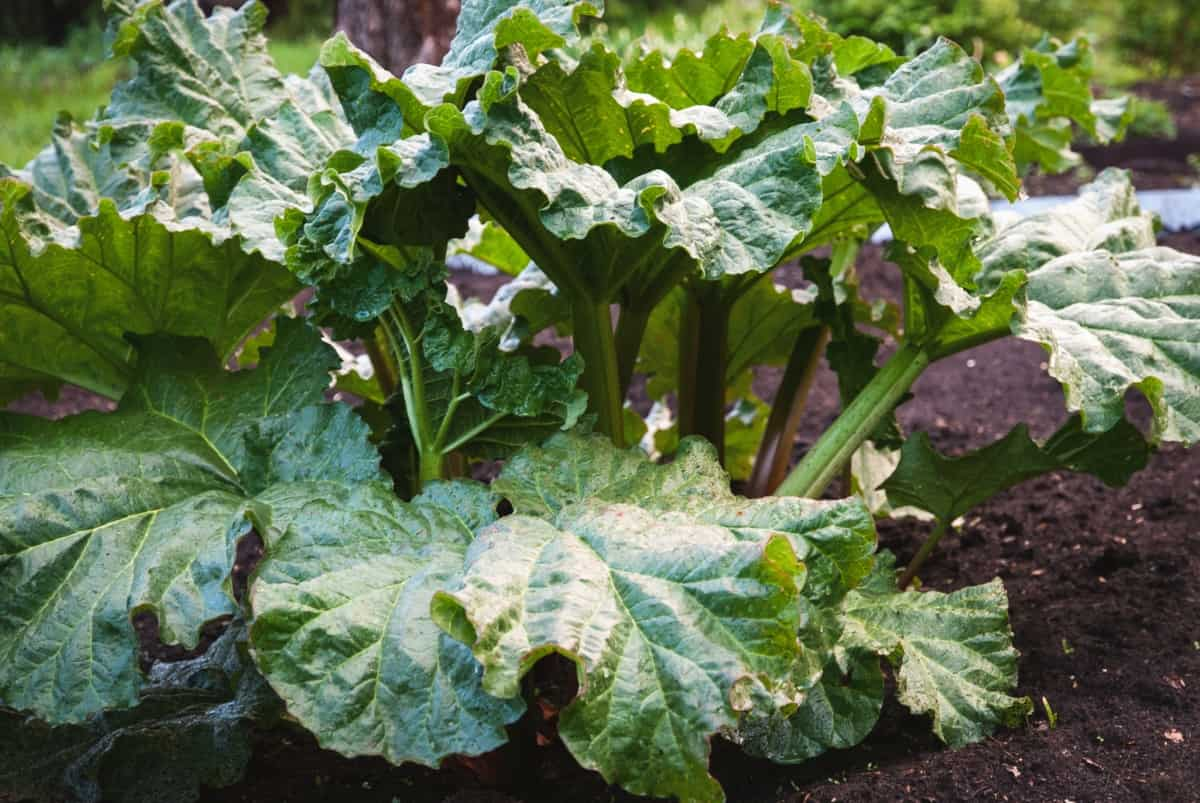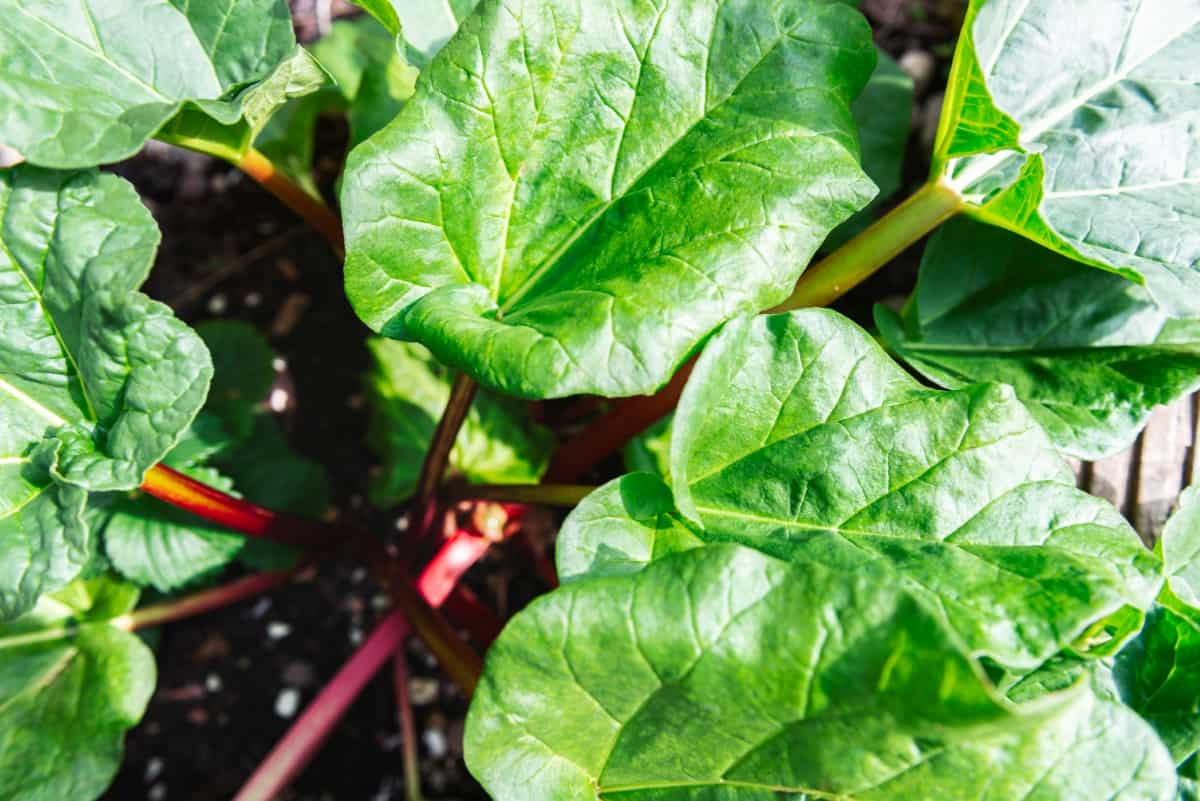The Rhubarb plant belongs to a group of plants of the genus Rheum in the plant family Polygonaceae. It is an excellent addition to the backyard garden, providing beautiful foliage and a versatile ingredient for various recipes.

How to Grow Rhubarb from Scratch
Best Soil for Growing Rhubarb
Choose a sunny location with well-drained soil. Rhubarb plants prefer slightly acidic soil with a pH of 6.0 to 6.8. Before planting, remove any weeds or debris from the area and dig a deep hole to accommodate the plant’s entire root system.
Tips for Growing Rhubarb in Hot Climates
- Choose the right location for your Rhubarb plant. It should be placed with partial shade to protect it from direct sunlight.
- In hot climates, rhubarb plants need more water than usual to survive and thrive.
- Fertilize your Rhubarb plants regularly with an organic fertilizer such as compost or well-rotted manure.
- Consider planting heat-tolerant varieties such as Victoria or Valentine, better suited to growing in warm regions than other types of Rhubarb.
Organic Fertilizer for Rhubarb Growth
One of the best types of organic fertilizer for Rhubarb is well-aged compost. Another great option is worm castings, also known as vermicompost. In addition to adding organic fertilizer before planting your Rhubarb crowns or seeds, you can apply a top dressing throughout the growing season using compost tea or fish emulsion.
Growing Rhubarb from Seeds
- Firstly, you’ll need to sow the seeds indoors in late winter or early spring. Fill seed trays with compost and sprinkle the tiny seeds evenly on top before covering them lightly with more compost. Water well and keep the soil moist by misting regularly.
- After germination, thin out weak seedlings so that only one strong plant remains per pot. When planting outside, choose a spot with plenty of sunlight and well-draining soil.
- Mulching around your Rhubarb plants will help retain moisture in the soil while suppressing weeds.
How to Grow Rhubarb in Containers
- Growing Rhubarb in containers is a great option for gardeners with limited space. Select a container 12 inches deep and wide enough to accommodate the plant’s roots.
- Next, fill the container with well-draining soil mixed with compost or aged manure. Plant one Rhubarb crown per container, ensuring it sits below the soil surface and is watered well.
- After that, locate your container in partial shade or full sun throughout the day. Regularly watering and mulching to retain moisture keeps the soil moist but not saturated.
Companion Plants for Rhubarb
It is an excellent method to maximize the potential of your garden. Great options for companion planting with Rhubarb are Garlic, Broccoli, Strawberry, Cabbage, Beetroot, Chives, Parsley, Dill, Sage, Rosemary, Thyme, Catnip, Tarragon, Allium, and Oregano.
Winter Care for Rhubarb Plants
- Remove any remaining leaves or plant debris around the base of the plant. This will prevent plant pests and diseases from overwintering in the soil.
- Additionally, be sure not to prune back your Rhubarb plants during the fall or winter months, as this can cause more harm. Instead, wait until early spring when new growth begins before removing dead stalks or foliage. Continue monitoring your Rhubarb plants throughout winter for signs of stress or disease.
In case you missed it: How to Grow Lucky Bamboo in Soil: A Guide for Planting to Care

Growing Rhubarb in Raised Beds
- It is a great method to ensure proper plant drainage and soil quality. Firstly, choose the right location for your raised bed, which should be an area that receives full sun or partial shade.
- Before filling the raised bed with soil, adding organic matter is important. Then this will help improve the soil structure and provide essential nutrients for your Rhubarb plants. Watering is crucial when growing Rhubarb in a raised bed.
Watering Schedule for Rhubarb Plants
Water your newly planted Rhubarb thoroughly to help settle it in place and encourage growth. When watering your Rhubarb plants, it’s essential to aim at the plant base and avoid getting water on its leaves or stems, as this can attract pests and diseases.
Growing Rhubarb in Shade or Partial Shade
- Rhubarb is known for its love of the sun and thrives in partial shade. You can grow Rhubarb successfully if you have a spot with 4 hours of sunlight daily.
- When planting Rhubarb in shade or partial shade, select a location with good drainage and amend the soil with organic matter.
Growing Rhubarb Indoors or in Greenhouses
- Growing Rhubarb indoors allows you to control the temperature and humidity levels, ensuring optimal growth conditions.
- Choose a large container to start growing Rhubarb indoors and fill it with nutrient-rich soil.
- In a greenhouse, you have more space to grow multiple plants at once. Select a location with plenty of sunlight throughout the day and provides adequate ventilation to prevent overheating.
Different Rhubarb Varieties for Home Gardens
- German Wine
- Glaskin’s Perpetual
- Cherry Red
- Chipman’s Canada Red
- Crimson Red
- Hardy Tarty
- Holstein’s Bloodred
- KangaRhu
Growing Rhubarb in Hydroponics
- Trying an ebb and flow system if you’re considering growing Rhubarb hydroponically. This system works by flooding the grow tray with nutrient-rich water and draining it back into a reservoir after a set amount of time. The plants absorb what they need from the water during this process.
- When setting up your ebb and flow system, choose a tray large enough to accommodate your Rhubarb plants’ root systems once fully mature. You’ll also need to monitor and adjust pH levels as needed.
Mulching Techniques for Growing Rhubarb
Mulching is an essential technique for growing Rhubarb. To mulch your Rhubarb properly, wait until the soil has warmed up in early spring before applying a 2-3 inch layer around the base of each plant. Use materials such as compost, straw, or shredded leaves for effective results.
Pruning and Dividing Rhubarb
- The ideal time for pruning is in early spring before new growth begins. You should remove any damaged leaves from the base of the plant and any flower stems that have appeared.
- Dividing Rhubarb can also help maintain its vitality. This process involves digging up the entire plant and separating it into several smaller sections with their root systems. Dividing every five years will encourage healthier growth.
Troubleshooting Common Rhubarb Problems and Pest Control Methods for Rhubarb
- One problem with growing Rhubarb is crown rot, which can be caused by poor drainage. To prevent this, ensure your soil has good drainage and avoid overwatering.
- If aphids are attacking your Rhubarb plants, consider introducing ladybugs or lacewings as natural predators to help control their population.
- If your Rhubarb leaves appear wilted or yellowed due to an infestation of aphids, spider mites, or a lack of soil nutrients. Consider adding organic fertilizers and using insecticidal soap to treat these pests.
Natural Remedies for Rhubarb Diseases
- One common issue is crown rot, which affects the base of the plant. To combat this disease, try applying a solution of approximately 1 part hydrogen peroxide and 9 parts water around the base of the plant.
- Another problem you might encounter is leaf spot. One simple remedy for this issue is spraying a mixture of equal amounts of milk and water onto affected leaves every two weeks until symptoms subside.
- If powdery mildew strikes your Rhubarb plants, mix one tablespoon each of baking soda and vegetable oil with one gallon of water in a spray bottle. Apply directly to affected areas two times per week until symptoms disappear.
In case you missed it: How to Grow Purple Custard Apple from Seed: A Step-By-Step Planting to Harvest Guide

Harvesting Rhubarb at the Right Time
The ideal time to harvest Rhubarb depends on your growing variety and location. The best way to tell if your Rhubarb is ready for harvesting is by size and color. Mature stalks should be about 10-15 inches long and have a deep red color. If they are still thin and green, give them more time to grow. To harvest your Rhubarb stalks, look for those thick and firm with a deep red.
Conclusion
Rhubarb is a perennial vegetable with thick, red stalks and large green leaves. Growing your Rhubarb not only provides fresh produce but also offers numerous health benefits while being environmentally friendly at the same time. With the right soil conditions and attention to care, you can enjoy this delicious vegetable year after year.
- Feed Your Flock for Less: Top 10 Tips to Save on Chicken Feed
- Ultimate Guide to Ossabaw Island Hog: Breeding, Raising, Diet, and Care
- Hatching Answers: The Top 10 Reasons Your Chickens Aren’t Laying Eggs
- Eggs and Economics: Breaking Down the Cost of Raising Backyard Chickens
- Defend Your Greens: Proven Methods to Keep Iguanas Out of Your Garden
- Ultimate Guide to Cinnamon Queen Chicken: A Comprehensive Guide for Beginners
- Ultimate Guide to California Tan Chicken: Breeding, Raising, Diet, Egg-Production and Care
- Ultimate Guide to Marsh Daisy Chicken: Breeding, Raising, Diet, and Care
- 10 Types of Chicken Farming Businesses You Can Start for Profits